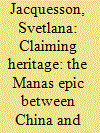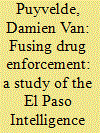| Srl | Item |
| 1 |
ID:
120701


|
|
|
|
|
| Publication |
2013.
|
| Summary/Abstract |
In the Indian subcontinent, the understanding of 'the family' in numerous narrative traditions has always extended into relationships with non-humans, with a pivotal emphasis on the guru-shishya (preceptor-disciple) relationship. This paper focuses on the highly popular English-language 'juvenile fiction' of Dhan Gopal Mukerji to suggest how he reconfigured these narrative traditions for a primarily non-Indian audience in the 1920s-30s. The paper considers Mukerji's young protagonists-invariably male, whether human or animal-in relation to the web of familial and outside social relationships through which the 'quest motif' is played out for a transnational readership. The epic form pervades his 'jungle books' through the figures of the animal protagonists, the search for a leader/guide/guru, and a re-imagining of caste, ethnicity and gender. Of particular interest is the composite mother figure. Dhan Gopal's oeuvre for children maps out a socialisation that is 'free' of the apparatus of the colonial home or of other disciplining institutional sites. Paradoxically, the search to be 'free from fear' can only be played in the alternative topos of the jungle, where violence is inescapable. How, if at all, may these narrative tropes be mapped onto contemporary history?
|
|
|
|
|
|
|
|
|
|
|
|
|
|
|
|
| 2 |
ID:
173334


|
|
|
|
|
| Summary/Abstract |
In this article I argue that the renewed promotion of the Manas epic in Kyrgyzstan after 2010 should not be reduced to an attempt to consolidate a national identity or strengthen the state by endorsing ethno-nationalism. Instead, since the 2009 inscription of the Manas epic on the UNESCO List of Intangible Heritage by China, Kyrgyzstan has undertaken a full-scale heritagization not only of the Manas epic but also of its other tangible or intangible cultural assets. This heritagization has been shaped by an anxiety that Kyrgyzstan’s most valuable cultural asset might be appropriated by China. By shifting the focus from Manas as a potential national role model to the epic as national heritage, I suggest that Kyrgyzstan’s latest outburst of ‘Manasification’ is better understood as an attempt to resist China’s ongoing attempts to harness the heritage discourse in rewriting the cultural and historical narrative of Eurasia.
|
|
|
|
|
|
|
|
|
|
|
|
|
|
|
|
| 3 |
ID:
144529


|
|
|
|
|
| Publication |
DelhI, Motilal Banarsidass Publishers, 2007.
|
| Description |
ix, 489p.hbk
|
| Standard Number |
9788120827387
|
|
|
|
|
|
|
|
|
|
|
|
Copies: C:1/I:0,R:0,Q:0
Circulation
| Accession# | Call# | Current Location | Status | Policy | Location |
| 058627 | 294.5/SHA 058627 | Main | On Shelf | General | |
|
|
|
|
| 4 |
ID:
093490


|
|
|
|
|
| Publication |
2010.
|
| Summary/Abstract |
Rustam is famed for being one of the most fleshed-out characters of the Shahnama. As such, this article will analyze an episode in his life of extreme emotional turbulence, in order to gain a closer understanding of how much realism Firdausi bestows upon his characters. This episode is the suicide attempt he makes following his act of filicide. I will begin with a discussion of the difficulties involved in interpreting such an ancient text as the Shahnama. An analysis of Rustam's background follows, tracing the development of his personality. I will then take a detailed look at the circumstances surrounding his attempted suicide. After this, I will gauge the extent to which this act may have its roots in his personality. By thus examining how realistic is Rustam's suicide attempt, I hope this paper will contribute to the further study of the literary nature of Firdausi's Shahnama.
|
|
|
|
|
|
|
|
|
|
|
|
|
|
|
|
| 5 |
ID:
147582


|
|
|
|
|
| Summary/Abstract |
This article examines the evolution of the El Paso Intelligence Center (EPIC), a key intelligence component of the Drug Enforcement Administration, to shed light on fusion efforts in drug enforcement. Since 1974, EPIC has strived to fuse the resources and capabilities of multiple government agencies to counter drug trafficking and related threats along the Southwest US border. While undergoing a steady growth, the Center has confronted a host of challenges that illuminate the uses and limits of multi-agency endeavors in drug enforcement. An evaluative study of the Center shows that it is well aligned with the federal government priorities in the realm of drug enforcement; however the extent to which the Center’s activities support the government’s efforts in this domain is not so clear. The Center needs to improve the way it reviews its own performance to better adapt and serve its customers.
|
|
|
|
|
|
|
|
|
|
|
|
|
|
|
|